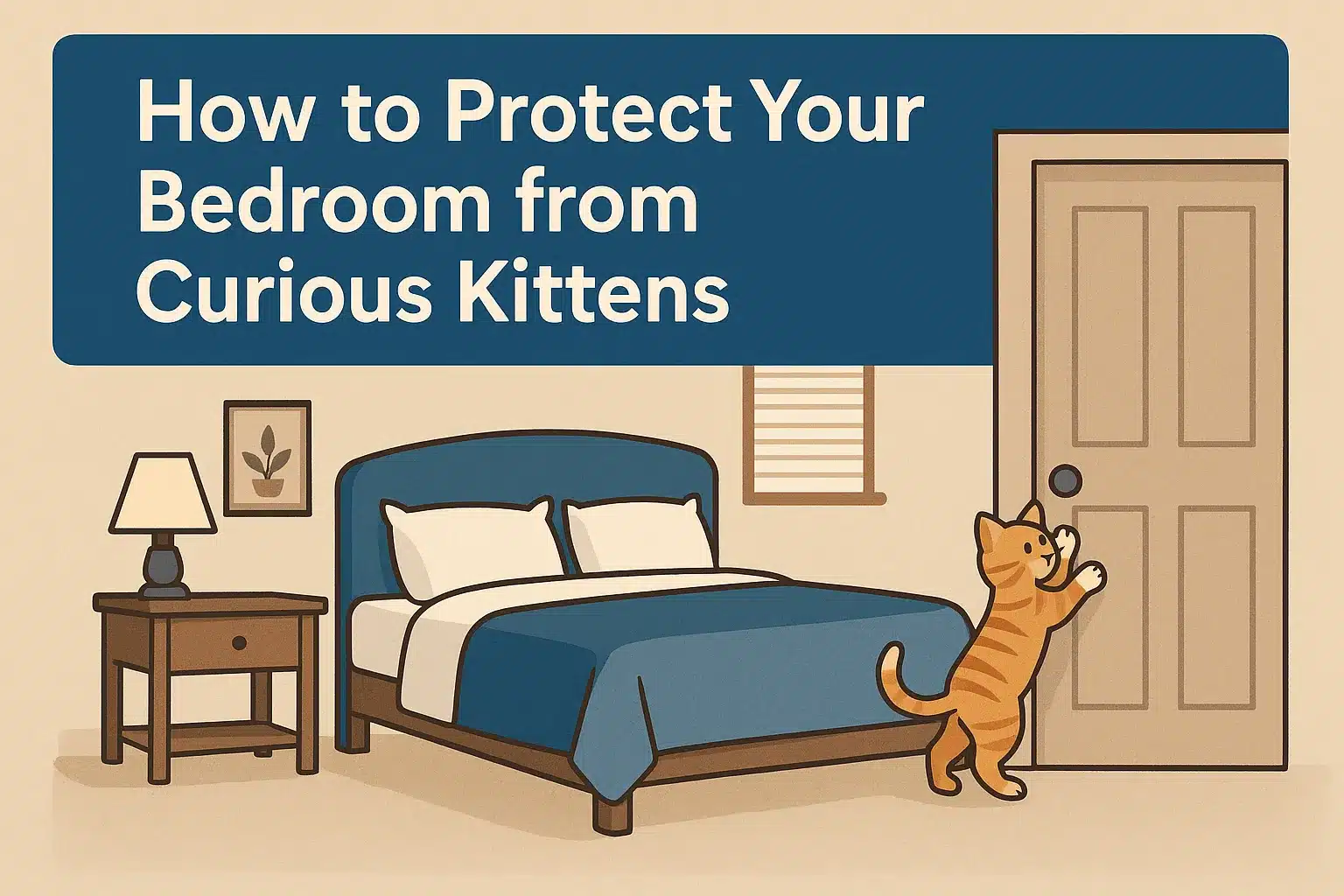
Creating a safe environment for your kitten in the bedroom is highly recommended since they possess a natural curiosity, which often leads them into risky situations. They love to climb, chew, and explore every nook and cranny. This behavior can result in accidents, such as getting caught in recliner chairs or chewing on electrical cords.
To protect your kitten and your belongings, you must learn how to kitten proof a bedroom. Once you understand their behavior and taking preventive measures, you ensure a safe and enjoyable space for your furry friend.
How to Kitten Proof a Bedroom
Creating a safe space for your kitten involves understanding potential hazards and taking proactive steps to mitigate them. This guide will help you learn how to kitten proof a bedroom effectively.
Identifying Potential Hazards
Kittens are naturally curious, which can lead them into dangerous situations. Identifying these hazards is the first step in ensuring their safety.
Electrical Cords and Outlets
Kittens love to chew on things, and electrical cords are no exception. To prevent accidents, use Cord Covers to secure all electrical cords. This not only prevents chewing but also keeps your kitten from becoming tangled.
Do also ensure that outlets are covered with safety plugs to avoid any unwanted shocks.
Small or Sharp Objects
Small items like rubber bands, needles, and pins can be easily swallowed by kittens, leading to choking or internal injuries. Keep these objects off surfaces within your kitten’s reach. Store them in drawers or containers with Safety Locks to ensure they remain out of sight and out of mind.
Toxic Plants and Substances
Many common household plants and substances can be toxic to kittens. Identify and remove any plants like lilies or poinsettias from the bedroom. Store cleaning supplies and medications in cabinets secured with childproof latches. This will prevent your kitten from accessing potentially harmful substances.
Step-by-Step Kitten Proofing
Once you’ve identified potential hazards, it’s time to take action. Follow these steps to kitten proof your bedroom.
What You Need
-
Cord Covers
-
Safety Locks
-
Childproof outlet covers
-
Storage containers
Detailed Instructions
-
Secure Electrical Cords: Use cord covers to bundle and hide cords. Place them out of reach or behind furniture.
-
Install Safety Locks: Attach childproof latches to cabinets and drawers containing hazardous items. This prevents your kitten from opening them.
-
Remove Small Objects: Clear surfaces of small or sharp objects. Store them in secured containers or drawers.
-
Check for Toxic Plants: Remove any toxic plants from the room. Replace them with pet-safe alternatives if desired.
-
Use Furniture Safety Straps: Secure heavy furniture to walls to prevent tipping. This ensures your kitten’s safety during their playful explorations.
Additional Considerations
Kitten proofing requires attention to detail and an understanding of your kitten’s behavior.
Who Should Try This?
Anyone with a kitten should consider kitten proofing their home. It’s especially important for first-time pet owners who may not be aware of the potential dangers.
Potential Challenges
You might face challenges such as limited space or difficulty in securing certain items. Be creative and resourceful in finding solutions that work for your specific situation.
Common Mistakes to Avoid
Avoid leaving food or drinks unattended, as kittens can easily knock them over or ingest something harmful. Ensure that all safety measures are consistently maintained and updated as your kitten grows and becomes more adventurous.
Common Concerns and What Else to Know
Common Concerns
When learning how to kitten proof a bedroom, you might encounter several common concerns. One frequent worry is whether the measures taken will be sufficient to keep your kitten safe. Kittens are agile and curious, often finding ways to explore areas you might not anticipate. To address this, regularly inspect your bedroom for new potential hazards.
As your kitten grows, their ability to reach higher places increases, necessitating ongoing vigilance.
Another concern involves the balance between safety and comfort. You want your bedroom to remain a pleasant space for both you and your kitten. Using Cord Covers can help maintain a tidy appearance while ensuring safety. These covers prevent your kitten from chewing on or becoming tangled in electrical cords, which is a common issue.
You might also worry about the cost of kitten-proofing supplies.
However, investing in essential items like Safety Locks and childproof latches can prevent costly accidents and vet bills. These locks keep cabinets containing cleaning supplies and other hazardous materials secure, protecting your kitten from potential harm.
What Else to Know
Understanding how to kitten proof a bedroom involves more than just addressing immediate hazards. It’s about creating an environment that supports your kitten’s natural behaviors while minimizing risks. Here are some additional tips to consider:
-
Routine Checks: Regularly check for new hazards as your kitten grows and becomes more adventurous. This proactive approach helps you stay ahead of potential dangers.
-
Training and Supervision: While kitten-proofing is essential, training your kitten to understand boundaries is equally important. Supervise their playtime and gently correct behaviors that could lead to accidents.
-
Pet-Safe Alternatives: Consider replacing toxic plants with pet-safe options. This not only beautifies your space but also ensures your kitten’s safety.
-
Interactive Toys: Provide plenty of toys to keep your kitten entertained. This reduces their interest in exploring potentially dangerous areas.
By following these guidelines, you create a safe and stimulating environment for your kitten. Remember, learning how to kitten proof a bedroom is an ongoing process that adapts as your kitten grows and changes.
Kitten-proofing your bedroom involves several key steps that provides a safe environment for your curious feline friends. Start by securing electrical cords and outlets, removing small or sharp objects, and eliminating toxic plants and substances. Implement safety measures like cord covers, safety locks, and furniture straps.
These actions protect your kitten from potential hazards and create a harmonious living space.

In her previous life, Lisa traveled extensively, both for work and leisure. After the pandemic struck, Lisa locked up her luggage and adopted a cat ever since.
Lisa is now an avid cat lover, she devotes most of her free time serving as butler to her adorable feline at home. When she is not with her cat, she can be seen using her phone sourcing for the latest cat supplies online.


